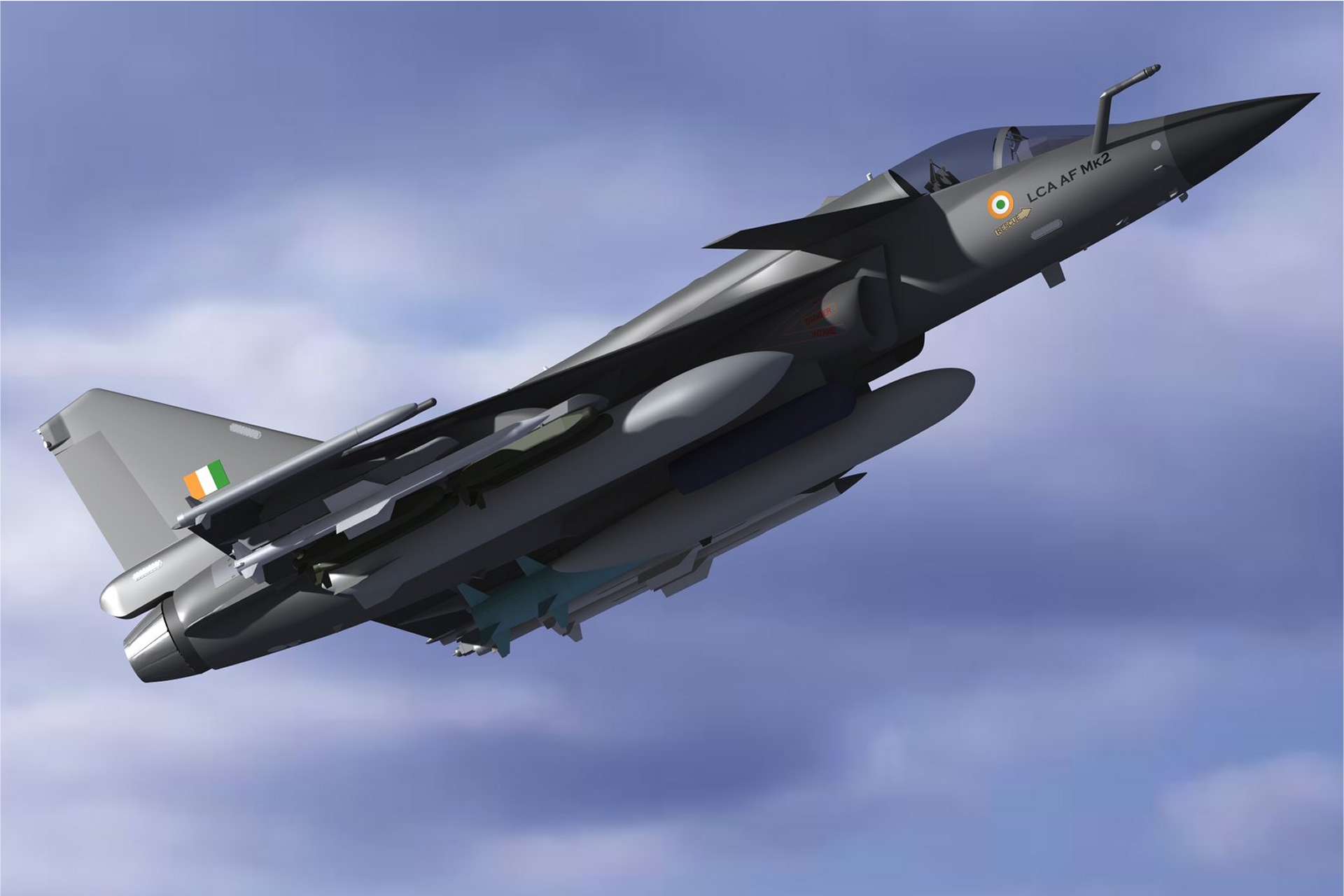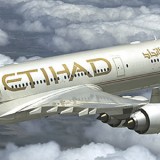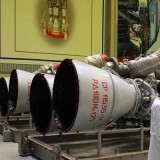Tejas MK-2 Prototype Set to Be Unveiled by End of 2025 with First Flight Expected in Early 2026

{loadposition bannertop}
{loadposition sidebarpub}
The Defence Aeronautical Development Agency (ADA) has confirmed a major advancement in the development of the Tejas MK-2 fighter jet, with the prototype expected to be unveiled by the end of 2025 and the first flight scheduled for early 2026. ADA’s Director General, Jitendra Jadhav, provided this update, assuring that the development of the MK-2 is progressing smoothly. The induction of the Tejas MK-2 into the Indian Air Force (IAF) is expected for 2028-2029, thus solidifying its role as the backbone of India’s fighter fleet.
Follow Army Recognition on Google News at this link
The Tejas MK-2 is being developed as a multi-role light combat aircraft capable of performing a wide range of operations. (Picture source: Indian MoD)
This development represents a significant step toward India’s self-reliance in defense aviation, as the Tejas MK-2 is designed to meet the demands of modern aerial combat while incorporating advanced technologies and systems. The MK-2 version is a larger and more powerful variant of the existing Tejas MK-1, with enhanced capabilities in avionics, radar, weapons, and engine performance.
The Tejas MK-2 is being developed as a multi-role light combat aircraft capable of performing a wide range of operations, including air-to-air combat, ground strikes, and reconnaissance missions. It is expected to feature a more powerful engine, a larger airframe, and enhanced radar systems, including an AESA (Active Electronically Scanned Array) radar.
In terms of armament, the MK-2 will be equipped with a variety of air-to-air and air-to-ground missiles, bombs, and rockets, expanding its combat versatility. The aircraft will also be equipped with modern electronic warfare suites and defensive systems to improve its survivability in contested environments. Additionally, the MK-2 will be designed to operate from short and challenging airstrips, making it highly versatile for the Indian Air Force’s needs.
The Tejas MK-2 is often compared to the AMCA (Advanced Medium Combat Aircraft), another fighter jet being developed in India, which is currently in the design phase. While both aircraft are intended to become essential elements of the IAF’s future fleet, there are notable differences between the two.
The AMCA is a fifth-generation stealth fighter designed to compete with high-tech foreign fighters, with stealth capabilities, a low radar cross-section, and advanced avionics. The MK-2, on the other hand, is a more conventional, fourth-generation-plus aircraft that builds on the technology of the original Tejas MK-1, with improvements aimed at meeting the current needs of the IAF.
The main difference lies in the role and capabilities of each aircraft. The Tejas MK-2 will complement existing fighters in the IAF fleet, while the AMCA will gradually replace older aircraft and will be positioned as a more advanced, long-term solution for the IAF. Both aircraft will share certain technologies, such as advanced avionics and radar systems, but the AMCA will incorporate stealth and supercruise capabilities, distinguishing it as a next-generation platform.
Alongside the MK-2, the AMCA is also progressing well, with Jadhav confirming that the prototype of the AMCA is expected to be unveiled in 2027, with its first flight scheduled for the end of 2028. This aircraft will be a key element in the modernization of the Indian Air Force, capable of competing with foreign fighters in terms of stealth and combat performance.
With both the Tejas MK-2 and AMCA expected to be unveiled in the coming years, the Indian Air Force is poised to take an important step forward in its self-reliance goals and combat readiness. The MK-2, with its induction planned for 2028-2029, will be a crucial addition to the IAF’s fleet, offering improved performance and capabilities. Meanwhile, the AMCA will provide India with a state-of-the-art stealth fighter to compete with the world’s most advanced aircraft.
The successful development of these two aircraft is not only a reflection of the growth of India’s defense industry but also an illustration of India’s ambitions to become a major global player in defense technologies.

{loadposition bannertop}
{loadposition sidebarpub}
The Defence Aeronautical Development Agency (ADA) has confirmed a major advancement in the development of the Tejas MK-2 fighter jet, with the prototype expected to be unveiled by the end of 2025 and the first flight scheduled for early 2026. ADA’s Director General, Jitendra Jadhav, provided this update, assuring that the development of the MK-2 is progressing smoothly. The induction of the Tejas MK-2 into the Indian Air Force (IAF) is expected for 2028-2029, thus solidifying its role as the backbone of India’s fighter fleet.
The Tejas MK-2 is being developed as a multi-role light combat aircraft capable of performing a wide range of operations. (Picture source: Indian MoD)
This development represents a significant step toward India’s self-reliance in defense aviation, as the Tejas MK-2 is designed to meet the demands of modern aerial combat while incorporating advanced technologies and systems. The MK-2 version is a larger and more powerful variant of the existing Tejas MK-1, with enhanced capabilities in avionics, radar, weapons, and engine performance.
The Tejas MK-2 is being developed as a multi-role light combat aircraft capable of performing a wide range of operations, including air-to-air combat, ground strikes, and reconnaissance missions. It is expected to feature a more powerful engine, a larger airframe, and enhanced radar systems, including an AESA (Active Electronically Scanned Array) radar.
In terms of armament, the MK-2 will be equipped with a variety of air-to-air and air-to-ground missiles, bombs, and rockets, expanding its combat versatility. The aircraft will also be equipped with modern electronic warfare suites and defensive systems to improve its survivability in contested environments. Additionally, the MK-2 will be designed to operate from short and challenging airstrips, making it highly versatile for the Indian Air Force’s needs.
The Tejas MK-2 is often compared to the AMCA (Advanced Medium Combat Aircraft), another fighter jet being developed in India, which is currently in the design phase. While both aircraft are intended to become essential elements of the IAF’s future fleet, there are notable differences between the two.
The AMCA is a fifth-generation stealth fighter designed to compete with high-tech foreign fighters, with stealth capabilities, a low radar cross-section, and advanced avionics. The MK-2, on the other hand, is a more conventional, fourth-generation-plus aircraft that builds on the technology of the original Tejas MK-1, with improvements aimed at meeting the current needs of the IAF.
The main difference lies in the role and capabilities of each aircraft. The Tejas MK-2 will complement existing fighters in the IAF fleet, while the AMCA will gradually replace older aircraft and will be positioned as a more advanced, long-term solution for the IAF. Both aircraft will share certain technologies, such as advanced avionics and radar systems, but the AMCA will incorporate stealth and supercruise capabilities, distinguishing it as a next-generation platform.
Alongside the MK-2, the AMCA is also progressing well, with Jadhav confirming that the prototype of the AMCA is expected to be unveiled in 2027, with its first flight scheduled for the end of 2028. This aircraft will be a key element in the modernization of the Indian Air Force, capable of competing with foreign fighters in terms of stealth and combat performance.
With both the Tejas MK-2 and AMCA expected to be unveiled in the coming years, the Indian Air Force is poised to take an important step forward in its self-reliance goals and combat readiness. The MK-2, with its induction planned for 2028-2029, will be a crucial addition to the IAF’s fleet, offering improved performance and capabilities. Meanwhile, the AMCA will provide India with a state-of-the-art stealth fighter to compete with the world’s most advanced aircraft.
The successful development of these two aircraft is not only a reflection of the growth of India’s defense industry but also an illustration of India’s ambitions to become a major global player in defense technologies.





